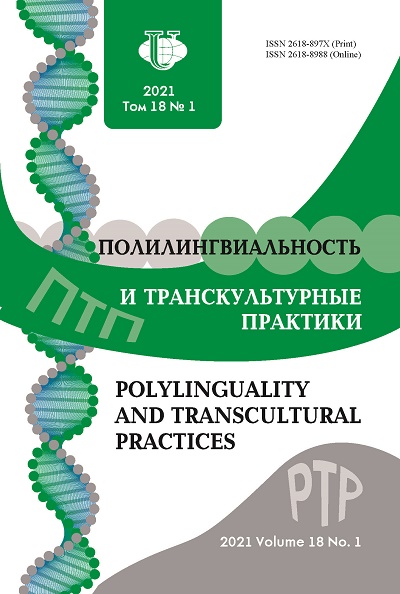Transculturalism and Its Manifestation in the Poetics of Lyric Texts
- Authors: Temirgazina Z.K.1
-
Affiliations:
- Pavlodar state pedagogical university
- Issue: Vol 18, No 1 (2021)
- Pages: 29-43
- Section: LITERARY SPACE
- URL: https://journals.rudn.ru/polylinguality/article/view/25933
- DOI: https://doi.org/10.22363/2618-897X-2021-18-1-29-43
Cite item
Full Text
Abstract
Using the example of the work of the Soviet Russian poet Pavel Nikolaevich Vasilyev, the author shows the representation of transcultural aesthetics in a literary text created in Russian by a Russian author, formed in the conditions of the “borderline” coexistence of two cultures: Russian and Kazakh. His works can be classified as “borderland literature”, in which the combination of the Russianlanguage discourse and the paradigm of the steppe, nomadic culture generates a hybrid text with a peculiar artistic aesthetics and poetics, which can be traced at the external and internal deep levels. The “I” of the author with “borderline” thinking has a stable ethnic identity, while openly showing its bicultural affiliation, which is quite consistent with the thesis about the flexibility of the cultural identity of a transcultural poet or writer. At the external text level of works of art, transculturalism finds expression in themes, in exoticisms, in foreign language insertions. The transcultural essence of the author’s consciousness generates hybrid texts containing symbiotic verbal images and techniques that demonstrate hybrid canons and symbols (symbols of wormwood, horse), incorporating elements of Kazakh and Russian cultural stereotypes and codes (stereotypical ideas about the Asian appearance of Kazakhs), which coexist without conflict in the artistic picture of the world of Vasilyev. As a result, a poetic picture of the world, unique in aesthetics, enriched with the paradigms of two different cultures, which is the property of the Russian cultural space, appears.
About the authors
Zifa K. Temirgazina
Pavlodar state pedagogical university
Author for correspondence.
Email: zifakakbaevna@mail.ru
Doctor of Philology, Professor of the Higher School of Humanities
60, Mira Str., Pavlodar, 140003, Republic of KazakhstanReferences
- Tlostanova, M.V. 2006. “Transculturation as a New Episteme of Globalization Epoch”. Bulletin of Peoples’ Friendship University of Russia. Series Philosophy 2 (12): 5—16. Print. (In Russ.).
- Tlostanova, M.V. 2012. “Transcultural studies. Demarcation of the New Disciplinary Area and the Future of the Humanities”. Bulletin of Peoples’ Friendship University of Russia. Series Philosophy 1: 91—102. Print. (In Russ.).
- Bakhtikereeva, U.M. 2009. Tvorcheskaja bilingval’naja lichnost’ (osobennosti russkogo teksta avtora tjurkskogo proishozhdenija). Astana: Izd-vo «CBOiMI». Print. (In Russ.).
- Dagnino, A. 2013. “Global Mobility, Transcultural Literature, and Multiple Modes of Modernity”. Transcultural Studies 2: 45—73. Print.
- Burtseva, Zh.V. 2008. “Transkul’turnaja model’ jakutskoj russkojazychnoj literatury: hudozhestvenno-jesteticheskie osobennosti”. Dissertation.. of a candidate of philological sciences. Yakutsk. Print. (In Russ.).
- Novokhatskiy, D. 2018. “Transkul’turnyj tekst i tendencii russkogo literaturnogo mejnstrima: «Tashkentskij roman» Suhbata Aflatuni”. Mundo Eslavo 18: 74—91. Print. (In Russ.).
- Far East. Web. URL: https://dv.land/people/russkii-aziat-iz-krasnogo-molodnyaka. Date of access 12.10.2020). Print. (In Russ.).
- Epshtein, M. 1995. Na granicah kul’tur: rossijskoe — amerikanskoe — sovetskoe. New York: Slovo. Print. (In Russ.).
- Krivoshchapova, T.V. 2009. “Transkul’turnaja pojetika stihotvorenija Pavla Vasil’eva “Aziat”. In Nasledie Pavla Vasil’eva v ego retroi perspektivnom okruzhenii. Almaty: Nuraj Print-Servis. Pp. 12—23. Print. (In Russ).
- Vasiliev, P.N. Poems. Web. URL: https://45parallel.net/pavel_vasilev/stihi/ Date of access 11.08.2020. (In Russ.).
- Kunjaev, C. “He was let to rise up and win”. Pavel Vasiliev. Writings. Letters. Web. URL: http:// libatriam.net/read/812606/ (Date of access 12.09.2020).
- Kovyneva, I.A., and Ye.V. Rubtsova. 2015. “Dve liry — odna sud’ba (sravnitel’nyj analiz pojezii P. Vasil’eva i S. Esenina)”. Innova 4 (1): 35—38. (In Russ.)
- Proshina, Z.G. 2017. Kontaktnaja variantologija anglijskogo jazyka: problemy teorii. World Englishes Paradigm. Moscow: Flinta. (In Russ.)
- Norton, B., and K. Toohey. 2011. “Identity, language learning, and social change”. Language Teaching 44 (4): 412—446. Print. doi: 10.1017/S0261444811000309.
- Dubovitskaya, M.A. 2019. “Inojazychnye vkraplenija v hudozhestvennom tekste kak sposob samoidentifikacii i avtoreprezentacii (na primere romana Amina Ar-Rejhani «Kniga Halida»)”. Literaturovedenie i lingvokul’turologija 17(1): 89—96. Print. doi: 10.24833/210-242-2019-117-89-96 (In Russ.)
- Zhenis, N., and Zh.K. Kiynova. 2018. “Transkul’turnyj podhod v ramkah izuchenija nacional’noj literatury”. Vestnik KazNU im. Al’-Farabi. Seriya filologicheskaya 17 (1): 89—96. Print. DOI: 10.24833 / 210-242-2019-1-17-89-96 (In Russ.).
- Protasova, N.A. 2019. “Transkul’turnost’ — novoe ponjatie v mire globalizacii”. In Na perekrestke kul’tur: edinstvo jazyka, literatury i obrazovanija. Mogilev: MGU imeni A.A. Kuleshova. Pp. 123—125. Print. (In Russ.)
- Temirgazina, Z.K. 2009. Sovremennye teorii v otechestvennoj i zarubezhnoj lingvistike. Pavlodar. Print. (In Russ.).
- Rudnyj Altaj. Web. URL: https://rudnyi-altai.kz/serdce-naraspev/ (Date of access 23.10.2020).















